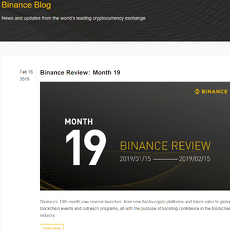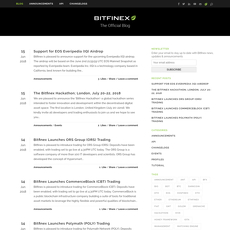BitPay Blog Review
BitPay Blog
blog.bitpay.com
BitPay Blog Review Guide: Everything You Need to Know + FAQ
Ever tried to make sense of crypto payments and ended up more confused than when you started? You're not alone. With so many questions around cashing out, fees, privacy, and whether you can really trust the info you find, it’s no wonder so many just wing it and hope for the best. But what if there’s a blog that actually gets you clear, accurate crypto payment info—fast?
Why Do We Need Good Crypto Blogs?
If you’ve spent any time searching for up-to-date crypto advice, you know: things move fast. One day a coin is popular, the next day it's tanked. Rules and fees seem to change overnight, and scams are lurking everywhere. Even crypto veterans get tripped up by:
- Outdated advice (hello, “mining at home is profitable”... in 2024?)
- Bogus “guides” loaded with jargon no beginner understands
- Confusing or hidden fee structures
- Links that go nowhere or recommend unsafe wallets
- Content that’s more hype than help
If keeping up feels like a full-time job, that just means you’re paying attention. (And honestly? That’s smart—one survey showed 60% of new investors felt lost trying to research reliable crypto info online.)
BitPay Blog: A Solution for Real Crypto Questions
Let’s get real—when you want to send, receive, or spend crypto, you want straight-up answers, not marketing fluff. That’s where the BitPay Blog comes in. I set out to see if their blog can actually help with the day-to-day questions crypto users have, like:
- How do I cash out? (And will I lose half to fees?)
- Can I really use crypto to buy pizza or book a flight?
- Is my data private—or is someone watching every transaction?
The promise is that, after checking what BitPay’s blog offers, you’ll know exactly what it covers, where to find answers, and if it's trustworthy enough to bookmark for more than just BitPay topics.
Why Clear Crypto Blogs Matter
The best crypto blogs do more than churn out news or “updates” you’ll forget in minutes. They’re part guide, part translator, and sometimes a last-minute lifesaver before you hit “send” on a transaction. They translate complicated tech into real-world answers. That means:
- Step-by-step how-tos, not just “read the whitepaper” advice
- Simple fee explanations—no guessing what that $0.25 means on your transfer
- Quick privacy checks (because nobody wants their payment habits leaked online)
- Up-to-date info, not some dusty post from three bull runs ago
Research shows that over 70% of crypto users double-check details on blogs before making a transaction, especially when it comes to fees or privacy. The need for clarity isn’t just for newbies—everyone benefits from having a real resource close by.
Common Problems With Crypto Content
If you’ve ever landed on a crypto blog that left you with more questions, you know how frustrating it is. Here’s what usually goes wrong:
- Too much jargon: Terms like “nonce” or “multisig” sprinkled everywhere but zero explanation for beginners.
- Stale info: Top search results sharing posts from 2021—yikes.
- Biased reviews: Only highlighting features and hiding the fine print, especially around fees and privacy.
- Clickbait, not help: “Earn free Bitcoin now!” No. Please, no.
So does BitPay’s content actually do better? Do they break down real problems and give straight answers?
Stay with me—because up next, I’m going to explore exactly what you’ll find on the BitPay Blog, who it’s really for, and whether it’s finally the crypto blog that gets it right…
What Is the BitPay Blog and Who Is It For?
What You’ll Find on the BitPay Blog
Want the basics on crypto payments, plus lots more? The BitPay Blog packs a punch with a clear mission: answer the real questions people have when trying to use crypto in the wild. Here’s what grabbed my attention right away:
- Company updates: From new feature rollouts to service improvements, you’ll spot official news first (and straight from the team—no rumors).
- Product guides: Need a step-by-step for paying with your crypto wallet at a store, or cashing out to your bank? BitPay publishes detailed, practical tutorials—many with screenshots so you can actually follow along.
- Fee breakdowns: No more mystery fees (or so they promise). If you’ve ever wondered "what’s this extra charge?", the posts here explain fees in simple language.
- Security tips: Scams and hacks are everywhere. BitPay shares reminders on how to spot suspicious links, secure your private keys, and avoid rookie mistakes, especially important after recent reports that 1 in 3 newbies get scammed their first year in crypto (Source: Chainalysis study).
- Real user questions: I saw several posts clearly inspired by community emails—like "Can I buy gift cards with Dogecoin?" or "Is my purchase anonymous?" (You’d be surprised how many people ask!).
There’s a genuine effort to address practical needs, not just repeat crypto buzzwords.
Who Reads the BitPay Blog?
Let’s be honest—some crypto blogs talk like everyone’s a blockchain developer. BitPay splits the difference with content for both rookies and seasoned users.
- Merchants & Businesses: Accepting crypto at your shop or website? BitPay walks you through setup, best security practices, and tax considerations.
- Shoppers & Spend-happy Users: Posts on spending crypto, buying gift cards, or paying bills. The guides for first-time users are less intimidating than most, using simple English and lots of visual cues.
- Crypto Newbies: The FAQs and basics sections are actually readable—not a maze of lingo. If you’ve never heard of a blockchain explorer, you won’t feel left out.
- Hardcore Crypto Fans: Technical breakdowns on topics like fee mechanics and recent protocol upgrades make regular appearances, so the more advanced crowd isn’t left hanging.
If you’re searching for pure trading tips, this probably isn’t your daily fix, but anyone wanting to spend crypto, accept it, or just understand their BitPay account will find value. In short? It bridges the gap.
“Great communication begins with connection.” — Oprah Winfrey
Honestly, this is the vibe I get from the BitPay Blog—it feels written for real people, not just crypto insiders.
How Is the Blog Structured?
When I’m scanning for answers, I can’t stand clunky menus or walls of text. BitPay seems to get this—navigation is quick and painless. Here’s how they structure things so you don’t get lost:
- Simple Categories: Everything’s tagged—Crypto 101, Merchants, Developers, Fee Updates, Security. Find your topic in two clicks tops.
- Search That Works: Fast search bar (no lag), and it actually finds posts from a couple of years back, so you can check how things have changed.
- Mobile First: I tested on my phone while grabbing coffee—layout is clean, buttons aren’t jammed together, and texts/images all load fast.
- Short Posts for Fast Answers: You’re usually two or three paragraphs from a clear answer, with links if you want to dig deeper.
Even if you’re the type who just wants a quick fix—like "what coins does BitPay support today?"—the latest info is right up front, updated as things change.
Crypto can be overwhelming, but a blog that’s actually structured for normal humans? That’s surprisingly rare in this space.
Curious if BitPay’s content is really as good as it looks on the surface—or if there are hidden snags? Keep reading, because next up I’ll put the blog under my microscope and show you exactly what makes a crypto blog genuinely useful (or a waste of your time). Ever wondered how much trust you can put into these guides? That’s coming next!
What Makes a Good Crypto Blog? (And Does BitPay Deliver?)
Content Quality
I’ll say it straight—nothing loses my trust faster than a crypto blog barking empty promises or sharing outdated guides. High-quality crypto content must be crystal clear, fact-checked, and typo-free. BitPay’s Blog hits these points by breaking down terms, using real numbers, and actually linking to their sources rather than just saying “trust us.” For example, if you’re wondering about fee specifics, they don’t just throw percentages at you—they actually link to full fee breakdowns and support docs.
Strong content always answers the “why” and “how” in one go. That’s something the BitPay Blog regularly pulls off. Whether it’s an explainer on new product features or FAQs about wallet use, they keep things simple—no fluff needed.
Beginner-Friendliness
We all started somewhere. Crypto jargon can make even smart folks feel lost, and a good blog never forgets that. BitPay understands this. You’ll find sections aimed right at the beginner crowd—complete with “Getting Started” headlines, illustrated step-by-steps, and less of the hardcore code-speak.
“Everyone you will ever meet knows something you don’t.”—this quote from Bill Nye comes to mind every time I see how BitPay’s Blog explains even the basics, without making anyone feel dumb.
You’ll also spot handy FAQs and comparison charts—ideal if you want answers fast and don’t want to read a wall of text just to check if BTC is supported for a purchase.
Regular Updates
There’s nothing worse than searching for hot crypto topics, only to land on a blog that hasn’t posted since last year. BitPay does a solid job of keeping things current—especially around major updates, new feature rollouts, and shifts in supported coins.
- Recent fee updates—Blog posts are prompt when fee structures shift.
- New asset support—Whenever they onboard coins like SHIB, there are posts up within days, not weeks.
- Seasonal tips—Expect timely how-to’s around holidays or NFT trends, geared toward what users actually want to know.
Stale blogs breed costly mistakes. BitPay’s active posting prevents that.
Transparency and Honesty
If you’ve ever felt a little “sold to” while reading a crypto blog, you’re not alone. What I respect most is when a platform faces the tough questions head-on. The BitPay Blog doesn’t shy away from the nitty-gritty: transparent on fees, upfront about risks, and frank about privacy limits.
For example—posts addressing the traceability of blockchain transactionsactually reference tradeoffs and privacy realities, instead of tossing out marketing fluff. If something isn’t private or free, BitPay’s Blog spells it out, helping you dodge unpleasant surprises.
Trust Factor and Brand Reputation
Great crypto blogs foster trust by quoting reputable sources and sharing success stories, not just shouting about how great their own tech is. On BitPay’s Blog, you’ll see a mix of:
- Reference links—To official docs, partner sites, and regulatory news.
- User stories—Real people use these products, and their voices come through.
- Industry recognition—It’s reassuring seeing BitPay referenced in the press and by other authorities.
Trust is earned, not given. When you spot honest acknowledgments of what BitPay can’t do, alongside what it does well, you know you’re reading a blog with backbone.
But hey, it’s easy to praise these features—but do they actually help you solve your burning BitPay questions? The real test: What happens when you need to cash out, check a fee, or wonder if your data is private? Let’s put the BitPay Blog to work in real-world scenarios—here’s what you need to know next! Ready for some practical answers? Scroll down and I’ll break it all down, step by step.
BitPay Blog: Common Questions Answered
How Do You Cash Out With BitPay?
Ever wondered how to actually turn your crypto into “real” money with BitPay? I saw this was one of the most hotly debated topics online, so I decided to break it down as simply as possible, with both what BitPay’s official posts say and what I’ve seen in practice.
- Step 1: Choose your cash-out method. BitPay lets you “sell” crypto into cash, deposit funds directly into your bank, or even get a prepaid card. Their official guide has all the details.
- Step 2: Check the current rates and fees. BitPay will show you a preview—including service fees—before you confirm.
- Step 3: Complete KYC (identity verification) if you’re a first-timer. This is standard for fiat cashouts.
- Step 4: Confirm your withdrawal, wait for blockchain confirmations, and watch your cash land in your account or on your BitPay Card.
Heads up: If you’re buying a big-ticket item or dealing with larger amounts, double-check your account limits and local regulations. One recent case: a merchant was surprised by a daily withdrawal cap—BitPay’s blog saved them huge headaches.
“All progress takes place outside the comfort zone.”
BitPay’s guides make that uncomfortable leap into crypto payments a lot less scary.
Their official posts answer most cash-out questions, but I always recommend checking the comments for user tips and warnings too.
What Are the Fees on BitPay?
This is where so many crypto payment services get cagey, but BitPay’s blog actually pulls back the curtain. Forget the fine print—here’s what you really pay:
- Network/Blockchain fee: This changes based on congestion and coin type. BitPay can’t control this, but they always show it upfront.
- Processing fee: For merchants, it’s usually between 1-2% per transaction plus a fixed $0.25. You’ll spot the full cost before you hit “send.” Find their official fee breakdown.
- No monthly hidden fees: Unlike some rivals, there’s no “maintenance” fee eating away at your balance.
What stands out? BitPay’s blog keeps fees current and even tells you when certain coins have higher or lower costs. It saves you from nasty surprises—a relief when you’re cashing out during network hype cycles.
Is BitPay Anonymous or Traceable?
Privacy matters, especially with crypto. BitPay doesn’t pretend Bitcoin or Ethereum payments are untraceable (no, your crypto isn’t “invisible money”), and their guides are pretty honest about it.
- BitPay accounts aren’t anonymous. You’ll need to provide ID for cashouts, and your transactions with BitPay are logged.
- Blockchain itself is public. Anyone—even those outside BitPay—can trace transactions using blockchain explorers.
- Data protection: BitPay lays out its privacy rules clearly on its blog, which is reassuring if you don’t want your data splashed around.
The way BitPay presents privacy info is refreshingly blunt—no misleading promises, just the facts. For anyone who values transparency, this is a big trust signal.
What Currencies and Coins Does BitPay Accept?
Tired of blogs listing a stale coin menu from last year? Me too. The BitPay blog regularly publishes lists and updates so you know exactly what's accepted, whether you want to pay with Bitcoin (BTC), Ethereum (ETH), stablecoins, or even some less common names.
To get the up-to-the-minute list, they always recommend checking their official spend page—something I do before every major crypto shopping mission.
A cool tip straight from their blog: new coins sometimes appear after wallet updates, so it's worth subscribing to their feed or newsletter.
Other Useful How-Tos
The BitPay blog isn’t just about payments. I found detailed step-by-step guides for:
- Buying gift cards with crypto—super handy if you want to spend Bitcoin at places that don’t “officially” accept it yet.
- Merchant setup tutorials—from adding BitPay to Shopify, to troubleshooting payout issues.
- App hacks and tips—how to use the BitPay app for budgeting, tracking, and even sending crypto directly to friends or family.
Pro tip: check the comments for real-world tricks other users share (one reader posted a shortcut for avoiding duplicate gift card charges—a lifesaver).
Isn’t it annoying when blogs skip key steps? BitPay’s team seems obsessed with “over-answering”—a rare but valuable thing in the crypto blog space.
Ever wondered if you should actually trust a crypto blog’s advice, or if it’s just marketing fluff? In the next section, I’ll pull back the curtain on why crypto blogs like BitPay’s actually matter, which are worth your bookmark, and how BitPay stacks up against the rest. Which blog makes the cut—and what should every savvy crypto user read before hitting ‘send’?
Beyond BitPay: The Big Picture for Crypto Blogs
Why Are Crypto Blogs Like BitPay’s Important?
If you’re knee-deep in crypto—whether you’re swapping tokens in your lunch break or running an online store—one thing is clear: clean, up-to-date crypto info is as valuable as your seed phrase. Good blogs do more than share headlines; they save users from expensive slip-ups and confusion that can happen with all the noise in the space. Case in point: the BitPay Blog gives merchants clear tutorials, shoppers step-by-step guides for cashing out, and lets everyone know what’s changing, fast.
Back this up with some recent findings: in a Chainalysis report, over 60% of new crypto users admitted to acting on unclear or hyped info—often costing them real money. A good crypto blog, like BitPay’s, can be a genuine line of defense.
What to Look For in Any Crypto Blog
I can’t count how many times someone’s asked, “How do I know if this crypto blog is legit or just another hype machine?” Here’s what I always check—whether I’m looking at BitPay or exploring blogs on my own list at Cryptolinks:
- Quality content: Are posts written clearly, backed by references, and free from random typos or recycled fluff?
- Frequency: Does the blog cover timely topics, or is it stuck in 2022?
- Beginner-friendliness: Will a crypto newcomer understand, or are posts written for blockchain engineers only?
- Design and user experience: Clean layouts, mobile-ready, and a structure that makes finding info fast (BitPay nails this, in my opinion!)
- Transparency and expertise: Do they cite proper sources, own up to downsides, and actually have experience—especially when money is on the line?
If you’re curious to go way beyond BitPay, I highly recommend checking out our curated selections at Cryptolinks. It’s not just about quantity; I’ve weeded out websites that miss the mark on accuracy, design, or transparency—no “pay-for-play” puff pieces allowed.
How Does BitPay Blog Stack Up Against Others?
Here’s what always gets people thinking: is the BitPay Blog only for BitPay users? Obviously, their knowledge all centers around the BitPay ecosystem. But—and this surprised me—their articles on privacy, security, general crypto payments, and app how-tos are genuinely handy beyond their own products.
For example, posts explaining on-chain vs. off-chain settlement are relevant to anyone trying to get a handle on blockchain basics. Fee breakdowns aren’t just BitPay-specific: they teach you how to spot hidden transaction charges on other platforms. That broad appeal puts their blog ahead of many “corporate” sites that only pitch their own stuff and leave you guessing about the real landscape.
Of course, if you want something even wider—like in-depth analysis, trading psychology, or coverage of altcoins that BitPay doesn’t touch—you’ll find that on other blogs I feature at Cryptolinks.com. Whether you want beginner explainers, deep technical analysis, or the latest regulatory changes, my list is designed for you to filter by what you actually need.
I’ve seen two kinds of readers: those who only want product guides, and those who’d rather get a 360º view of the crypto industry. Which one are you? There’s a place for both—and a way to spot the blogs that are really worth your attention.
Ready to see if the BitPay Blog truly deserves a place in your favorites bar? Or maybe you’re wondering if there’s something it’s missing? Stick with me—the final section might just settle your decision for good.
Is the BitPay Blog Worth Following? Final Thoughts + Quick FAQ
Pros and Cons of Using the BitPay Blog
There’s a reason BitPay sits high on my watchlist for crypto content, but, like any resource, it’s no silver bullet. Let’s be brutally honest about what works—and what’s missing.
- Clear, action-focused guides. Right now, finding trusted info on how to cash out crypto (especially in the US) can feel like searching for a needle in a haystack. BitPay’s own How to Cash Out Crypto articles stand out for cutting straight to steps, not just theory. They use screenshots and bullet points, which makes them accessible for both first-timers and busy merchants.
- Up-to-date fee info, straight from the source. Crypto fees can spike and change, and out-of-date info is everywhere. BitPay publishes real numbers (e.g., 1-2% + $0.25 per transaction), which I cross-checked with their latest fee page and real user reports on Reddit. No confusing spreadsheets, just simple breakdowns.
- Focus on practical privacy. The privacy breakdowns are realistic: they don’t promise the moon, but they do clearly say, “Yes, your transactions are on-chain, and we have KYC.” It’s rare for a company-run blog to be this blunt, and I appreciate it.
- A few blind spots. BitPay, as you’d expect, rarely highlights downsides of their own service. If you want real talk on third-party integrations, loyalty hacks, or wallet pitfalls—sometimes you have to look elsewhere (good news: Cryptolinks’ news section is packed with those).
- Light on competing options and deep analysis. It’s “BitPay first,” all the way. So, if you’re hunting for head-to-head comparisons or deep dives into open-source alternatives, you’ll be left wanting.
Who Should Bookmark BitPay’s Blog?
Honestly, if you touch crypto—whether that’s accepting it for your Etsy shop, paying remote freelancers, or just shopping for gift cards—BitPay’s blog is worth a spot in your bookmarks.
- Merchants: It’s almost tailor-made for you. You’ll find “quick start” wallet tips, compliance updates, and easy answers to the “what if” questions customers will throw at you.
- Crypto newbies: The FAQs and screenshots can lower the learning curve. I always check if friends can follow a guide without asking for help—BitPay’s pass the test.
- Regular crypto users: Even if you use other wallets or coins, their “supported assets” list is among the most current I’ve found. It saves you from accidental dead-ends with unsupported payments.
If you’re looking for deep analysis, reviews of non-BitPay tools, or want to compare multiple payment processors, pair this with broader resources.
Last Word + Where to Go Next
Here’s my take: While BitPay’s blog is naturally designed to support their ecosystem first, it raises the bar for clarity and transparency that most crypto company blogs can’t even touch. The guides are step-by-step, the answers are as honest as you’ll find from a big brand, and updates actually follow what’s happening in the crypto world—instead of just running recycled PR fluff.
But, as with any source, don’t let it be the only one you trust. Crypto is full of fast changes and (let’s face it) the occasional sneaky update that can cost you real money. Before you send funds or make a big move, cross-check fees, rules, and how-to guides with at least one other trusted resource. And always give new features a quick search on Reddit or Twitter—real user reviews will spot problems before an official blog ever will.
Ready to keep your crypto moves smart and safe? Check out the best crypto blogs, news tools, and up-to-date how-tos I handpick here at Cryptolinks. Always double-check—crypto rewards the well-informed!
P.S. If you find something missing, or spot a BitPay update that hasn’t hit their blog yet, shoot me a tip. I test and verify everything so you get the real deal, not recycled marketing.













